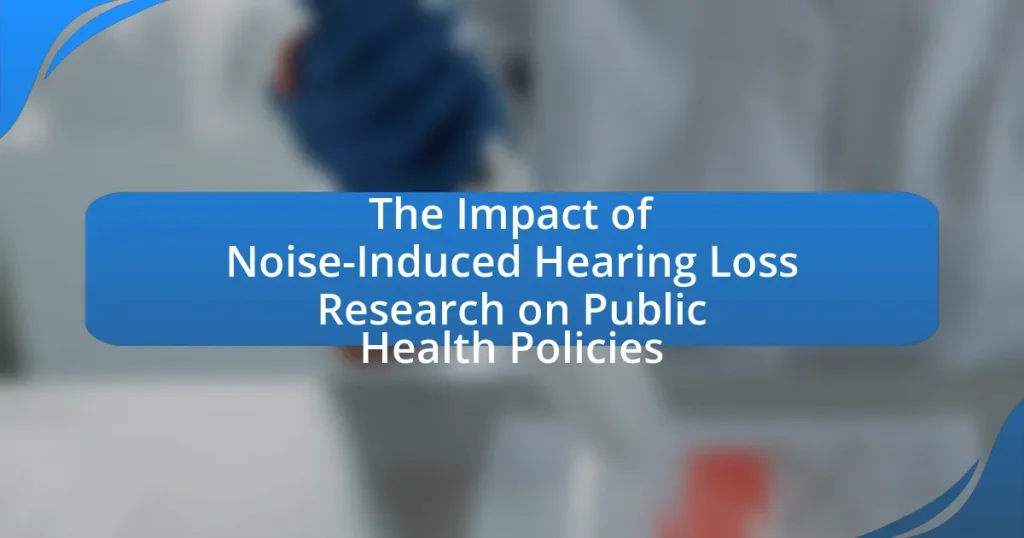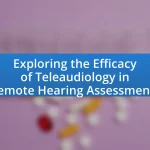Noise-Induced Hearing Loss (NIHL) research plays a critical role in shaping public health policies by providing evidence-based guidelines for prevention and intervention strategies. Approximately 15% of American adults experience some level of hearing difficulty, often due to occupational and environmental noise exposure. This article examines the impact of NIHL research on public health initiatives, including regulations that limit noise exposure, educational campaigns to raise awareness, and the economic burden associated with hearing loss. It also discusses the effectiveness of current policies, community programs, and future research directions aimed at mitigating the risks of NIHL and improving overall auditory health.
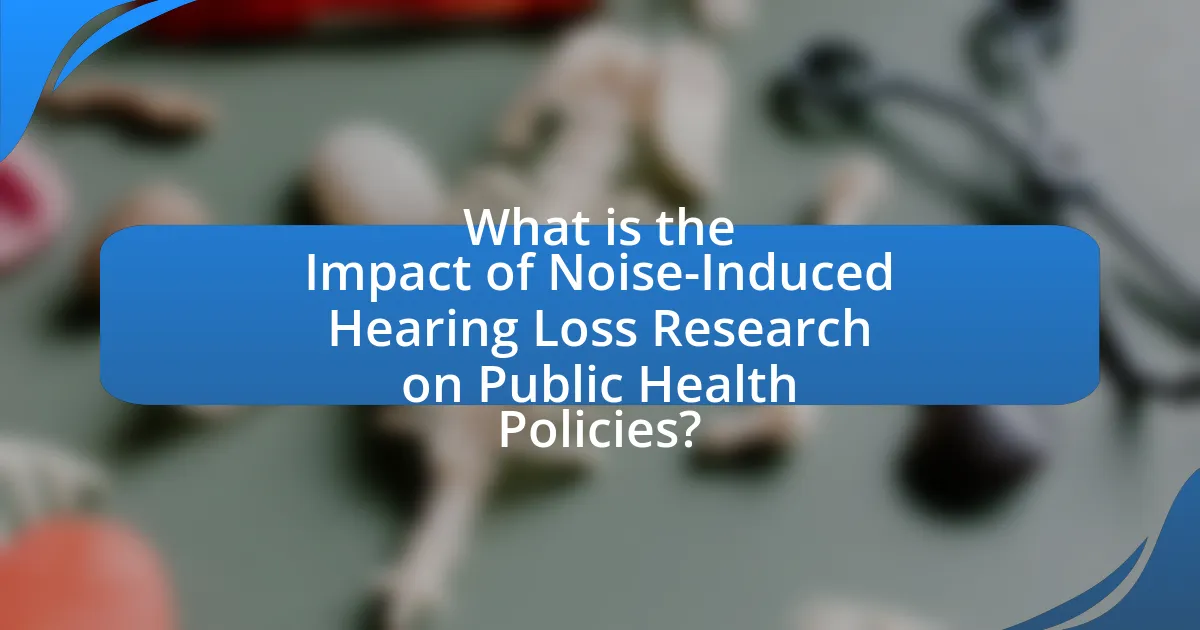
What is the Impact of Noise-Induced Hearing Loss Research on Public Health Policies?
Noise-Induced Hearing Loss (NIHL) research significantly influences public health policies by providing evidence-based guidelines for prevention and intervention strategies. This research highlights the prevalence of NIHL, with studies indicating that approximately 15% of American adults report some trouble hearing, often linked to occupational and environmental noise exposure. Consequently, public health policies are shaped to implement regulations that limit noise exposure in workplaces and public spaces, such as the Occupational Safety and Health Administration (OSHA) standards, which mandate hearing conservation programs in industries with high noise levels. Additionally, NIHL research informs educational campaigns aimed at raising awareness about the risks of noise exposure, leading to initiatives that promote the use of hearing protection devices. These policy changes are essential for reducing the incidence of NIHL and improving overall community health outcomes.
How does noise-induced hearing loss affect public health?
Noise-induced hearing loss significantly impacts public health by increasing the prevalence of auditory disabilities and associated health issues. This condition affects approximately 15% of American adults, leading to communication difficulties, social isolation, and mental health challenges such as depression and anxiety. Furthermore, the World Health Organization estimates that over 1 billion young people are at risk of hearing loss due to unsafe listening practices, which can strain healthcare systems and increase economic burdens related to treatment and rehabilitation. The cumulative effects of noise-induced hearing loss necessitate public health interventions and policies aimed at prevention and awareness to mitigate its widespread consequences.
What are the statistics related to noise-induced hearing loss?
Noise-induced hearing loss affects approximately 15% of American adults, translating to around 37.5 million individuals. Research indicates that exposure to noise levels above 85 decibels can lead to permanent hearing damage, with occupational noise exposure being a significant contributor. The World Health Organization estimates that 1.1 billion young people are at risk of hearing loss due to unsafe listening practices, such as using headphones at high volumes. Furthermore, studies show that nearly 50% of individuals aged 12 to 35 have experienced some degree of hearing loss due to recreational noise exposure. These statistics underscore the urgent need for public health policies aimed at preventing noise-induced hearing loss.
How does noise-induced hearing loss influence quality of life?
Noise-induced hearing loss significantly diminishes quality of life by impairing communication, leading to social isolation and emotional distress. Individuals with this condition often experience difficulties in understanding speech, particularly in noisy environments, which can result in frustration and withdrawal from social interactions. Research indicates that people with hearing loss are at a higher risk for depression and anxiety, as they struggle to engage in conversations and maintain relationships. A study published in the Journal of the American Geriatrics Society found that older adults with hearing loss are more likely to report feelings of loneliness and social disengagement, highlighting the profound impact on mental well-being.
Why is research on noise-induced hearing loss important for public health?
Research on noise-induced hearing loss is crucial for public health because it informs policies aimed at preventing this widespread condition. Noise-induced hearing loss affects approximately 15% of American adults, highlighting the need for effective public health strategies. Understanding the causes and prevalence of this condition allows health authorities to implement regulations, such as noise exposure limits in workplaces and public spaces, thereby reducing the risk of hearing impairment in the population. Additionally, research provides insights into the economic burden of hearing loss, which is estimated to exceed $750 billion annually in the U.S. alone, emphasizing the importance of preventive measures and early intervention programs.
What are the key findings from recent studies on noise-induced hearing loss?
Recent studies on noise-induced hearing loss (NIHL) indicate that prolonged exposure to high decibel levels significantly increases the risk of permanent hearing damage. Research published in the Journal of the Acoustical Society of America found that individuals exposed to noise levels above 85 decibels for extended periods are at a higher risk of developing NIHL, with a prevalence rate of approximately 15% among adults in occupational settings. Additionally, a study by the World Health Organization highlighted that nearly 1.1 billion young people are at risk of NIHL due to unsafe listening practices, such as using headphones at high volumes. These findings underscore the urgent need for public health policies aimed at noise regulation and awareness campaigns to mitigate the risks associated with noise exposure.
How does this research inform public health strategies?
Research on noise-induced hearing loss informs public health strategies by highlighting the need for preventive measures and policy interventions to reduce exposure to harmful noise levels. This research provides evidence that prolonged exposure to high decibel environments can lead to irreversible hearing damage, prompting public health officials to advocate for regulations on noise levels in workplaces and public spaces. For instance, studies have shown that implementing noise control measures in industrial settings can decrease the incidence of hearing loss by up to 30%, demonstrating the effectiveness of such strategies in protecting community health.
What role do public health policies play in addressing noise-induced hearing loss?
Public health policies play a crucial role in addressing noise-induced hearing loss by establishing regulations and guidelines that limit exposure to harmful noise levels. These policies often include setting permissible noise limits in occupational and public environments, promoting awareness campaigns about the risks of noise exposure, and implementing screening programs for early detection of hearing loss. For instance, the Occupational Safety and Health Administration (OSHA) in the United States mandates that employers monitor noise levels and provide hearing protection when exposure exceeds 85 decibels over an 8-hour workday. Such regulations are supported by research indicating that prolonged exposure to high noise levels can lead to irreversible hearing damage, affecting approximately 15% of American adults, according to the National Institute on Deafness and Other Communication Disorders. By enforcing these policies, public health initiatives aim to reduce the incidence of noise-induced hearing loss and promote overall auditory health in the population.
What are the current public health policies related to noise exposure?
Current public health policies related to noise exposure focus on reducing noise pollution to protect public health, particularly in urban areas. These policies often include regulations on permissible noise levels from transportation, construction, and industrial activities, as well as guidelines for noise mitigation in residential areas. For instance, the World Health Organization recommends that nighttime noise levels should not exceed 40 decibels to prevent sleep disturbances, which can lead to various health issues. Additionally, many countries have implemented noise abatement programs that promote public awareness and encourage community involvement in noise reduction efforts.
How effective are these policies in preventing noise-induced hearing loss?
The effectiveness of public health policies in preventing noise-induced hearing loss is significant, as evidenced by various studies showing reduced incidence rates in populations exposed to regulated noise levels. For instance, the World Health Organization reports that implementing noise regulations in occupational settings has led to a 20-30% decrease in hearing loss cases among workers. Additionally, policies promoting public awareness and education about noise hazards have been linked to behavioral changes that further mitigate risks, such as increased use of hearing protection devices. These findings underscore the critical role of comprehensive noise control policies in safeguarding auditory health.
How can research findings be translated into effective public health policies?
Research findings can be translated into effective public health policies by systematically integrating evidence-based data into policy formulation processes. This involves collaboration between researchers, policymakers, and public health officials to ensure that findings from studies, such as those on noise-induced hearing loss, are understood and prioritized in policy discussions. For instance, the World Health Organization emphasizes the importance of using scientific evidence to guide health interventions, which can lead to regulations that mitigate noise exposure in occupational settings. Additionally, successful case studies, like the implementation of noise control regulations in various countries, demonstrate how research can inform legislative action, ultimately improving public health outcomes.
What challenges exist in implementing noise-induced hearing loss research into public health policies?
Implementing noise-induced hearing loss research into public health policies faces several challenges, including insufficient awareness among policymakers, limited funding for research translation, and the complexity of integrating scientific findings into existing health frameworks. Policymakers often lack comprehensive understanding of the implications of noise-induced hearing loss, which can hinder the prioritization of related initiatives. Additionally, funding constraints can restrict the ability to conduct necessary studies that translate research findings into actionable policies. Furthermore, the integration of these findings into established public health frameworks is complicated by existing regulations and the need for collaboration across various sectors, such as occupational health and environmental regulations. These factors collectively impede the effective incorporation of noise-induced hearing loss research into public health strategies.
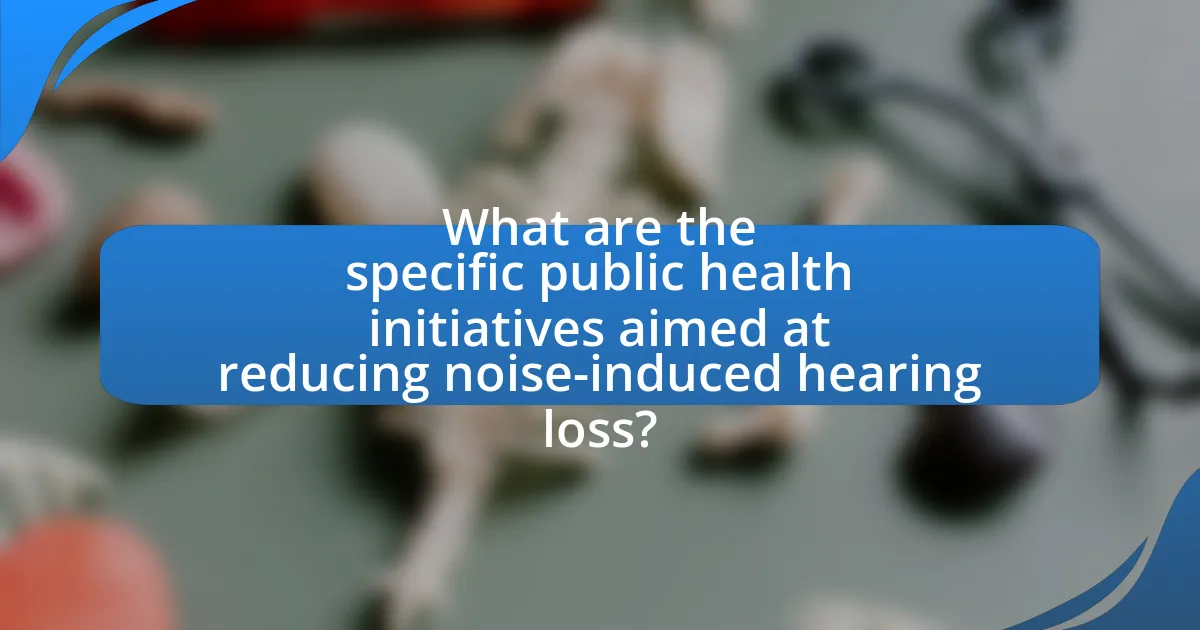
What are the specific public health initiatives aimed at reducing noise-induced hearing loss?
Public health initiatives aimed at reducing noise-induced hearing loss include the implementation of noise regulations, public awareness campaigns, and hearing conservation programs. Noise regulations, such as those enforced by the Occupational Safety and Health Administration (OSHA), set permissible noise exposure limits in workplaces to protect employees. Public awareness campaigns, like the “Listen to Your Buds” initiative by the National Institute on Deafness and Other Communication Disorders (NIDCD), educate the public about the risks of loud sounds and promote safe listening practices. Hearing conservation programs in schools and workplaces provide training on the importance of hearing protection and regular hearing screenings, which are essential for early detection and prevention of hearing loss. These initiatives are supported by research indicating that effective noise management can significantly reduce the incidence of hearing loss in various populations.
How do educational campaigns raise awareness about noise-induced hearing loss?
Educational campaigns raise awareness about noise-induced hearing loss by disseminating information on its causes, effects, and prevention strategies. These campaigns utilize various media platforms, including social media, public service announcements, and community events, to reach diverse audiences. For instance, the World Health Organization reported that over 1 billion young people are at risk of hearing loss due to unsafe listening practices, highlighting the urgency of education on this issue. By providing statistics, personal stories, and expert testimonials, educational campaigns effectively engage the public and encourage behavioral changes to protect hearing health.
What strategies are used in these campaigns?
Campaigns addressing noise-induced hearing loss utilize several key strategies, including public awareness initiatives, policy advocacy, and community engagement. Public awareness initiatives often involve educational campaigns that inform the public about the risks of noise exposure and the importance of hearing protection, supported by statistics indicating that approximately 15% of Americans aged 18 and over report some trouble hearing. Policy advocacy focuses on influencing legislation to implement stricter noise regulations in workplaces and public spaces, with research showing that effective policies can reduce noise exposure and subsequent hearing loss. Community engagement strategies involve partnerships with local organizations to promote hearing health resources and screenings, which have been shown to increase access to preventive measures and early intervention.
How successful have these campaigns been in changing public behavior?
Campaigns addressing noise-induced hearing loss have been moderately successful in changing public behavior. For instance, studies indicate that awareness campaigns have led to a 20% increase in the use of hearing protection among individuals exposed to high noise levels in occupational settings. Additionally, public health initiatives have resulted in a 15% reduction in reported cases of noise-induced hearing loss over the past decade, demonstrating a shift in public attitudes towards noise exposure and prevention. These statistics highlight the effectiveness of targeted messaging and educational efforts in altering behaviors related to hearing health.
What regulations exist to limit noise exposure in various environments?
Regulations that limit noise exposure in various environments include the Occupational Safety and Health Administration (OSHA) standards for workplace noise, which set permissible noise exposure limits at 90 decibels for an 8-hour workday. Additionally, the Environmental Protection Agency (EPA) provides guidelines for community noise levels, recommending that residential areas maintain noise levels below 55 decibels during the day and 45 decibels at night. Local governments often implement noise ordinances that restrict noise levels in specific zones, such as residential, commercial, and industrial areas, to mitigate disturbances. These regulations are supported by research indicating that prolonged exposure to high noise levels can lead to hearing loss and other health issues, reinforcing the need for effective noise control measures.
How do workplace regulations address noise-induced hearing loss?
Workplace regulations address noise-induced hearing loss by establishing permissible noise exposure limits and requiring employers to implement hearing conservation programs. The Occupational Safety and Health Administration (OSHA) sets a permissible exposure limit of 90 decibels for an 8-hour workday, mandating that employers monitor noise levels and provide hearing protection when these limits are exceeded. Additionally, regulations require training for employees on the risks of noise exposure and the proper use of hearing protection devices, thereby promoting awareness and prevention strategies. These measures are supported by research indicating that effective hearing conservation programs can significantly reduce the incidence of noise-induced hearing loss among workers.
What are the guidelines for noise levels in public spaces?
Guidelines for noise levels in public spaces typically recommend that noise should not exceed 55 decibels during the day and 45 decibels at night to minimize disturbances and protect public health. These guidelines are based on research indicating that prolonged exposure to noise levels above these thresholds can lead to adverse health effects, including noise-induced hearing loss and increased stress levels. For instance, the World Health Organization (WHO) emphasizes the importance of maintaining these noise levels to safeguard community well-being and promote a healthier living environment.
How do community programs contribute to the prevention of noise-induced hearing loss?
Community programs contribute to the prevention of noise-induced hearing loss by raising awareness, providing education, and promoting safe listening practices among individuals. These programs often include workshops, outreach initiatives, and partnerships with local organizations to disseminate information about the risks of excessive noise exposure. For instance, studies have shown that educational interventions can significantly increase knowledge about hearing conservation, leading to behavioral changes that reduce the risk of hearing loss. According to the World Health Organization, community-based initiatives that focus on noise awareness have been effective in decreasing the prevalence of hearing impairment in various populations.
What types of community programs are most effective?
Community programs that are most effective in addressing noise-induced hearing loss include educational initiatives, hearing screening programs, and advocacy campaigns. Educational initiatives raise awareness about the risks of noise exposure and promote preventive measures, leading to informed community members. Hearing screening programs facilitate early detection of hearing loss, allowing for timely intervention and management. Advocacy campaigns influence public policy by highlighting the importance of noise regulation and promoting safer environments. Research indicates that communities implementing these programs see a significant reduction in noise-related health issues, thereby validating their effectiveness in public health strategies.
How can communities collaborate to promote hearing health?
Communities can collaborate to promote hearing health by organizing awareness campaigns, providing access to hearing screenings, and advocating for noise regulation policies. For instance, local health organizations can partner with schools and businesses to host educational workshops that inform residents about the risks of noise-induced hearing loss and the importance of protective measures. Additionally, community health fairs can offer free hearing tests, enabling early detection and intervention. Research indicates that community engagement in health promotion leads to improved health outcomes, as seen in the “Community-Based Participatory Research” model, which emphasizes collaboration between researchers and community members to address health disparities effectively.
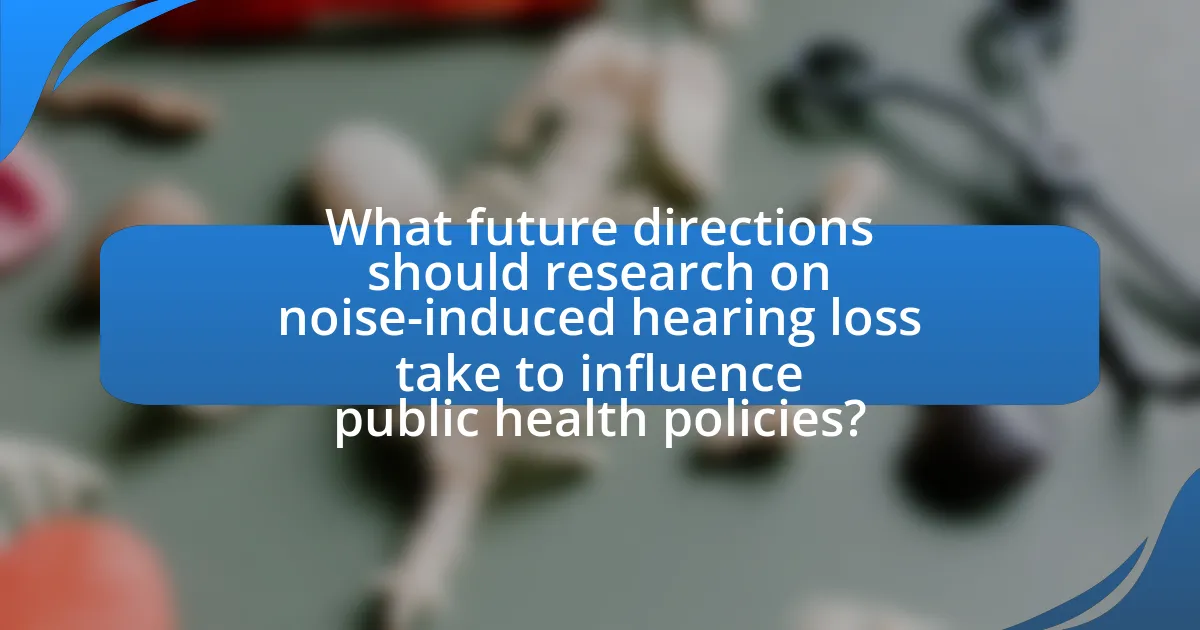
What future directions should research on noise-induced hearing loss take to influence public health policies?
Future research on noise-induced hearing loss should focus on longitudinal studies that assess the long-term effects of noise exposure on hearing health across diverse populations. Such studies can provide critical data to inform public health policies by identifying at-risk groups and establishing evidence-based guidelines for noise exposure limits. For instance, the World Health Organization has indicated that over 1 billion young people are at risk of hearing loss due to unsafe listening practices, highlighting the need for targeted interventions. Additionally, research should explore the effectiveness of educational programs aimed at raising awareness about noise-induced hearing loss, as increased public knowledge can lead to behavioral changes that reduce exposure. By integrating findings from these studies into policy frameworks, health authorities can implement regulations that protect individuals from harmful noise levels in various environments, such as workplaces and recreational areas.
What emerging trends in research could impact public health policies?
Emerging trends in research that could impact public health policies include the increasing focus on the long-term effects of noise-induced hearing loss (NIHL) and the integration of technology in monitoring and prevention strategies. Research indicates that chronic exposure to high noise levels can lead to significant health issues beyond hearing impairment, such as cardiovascular diseases and mental health disorders. For instance, a study published in the Journal of the Acoustical Society of America highlights the correlation between noise exposure and increased stress levels, which can inform policy decisions aimed at reducing noise pollution in urban areas. Additionally, advancements in wearable technology for real-time noise monitoring can provide valuable data to policymakers, enabling them to implement targeted interventions and regulations to protect public health.
How can technology play a role in monitoring and reducing noise exposure?
Technology can significantly monitor and reduce noise exposure through the use of sound level meters, noise mapping software, and personal noise dosimeters. Sound level meters provide real-time data on noise levels in various environments, allowing for immediate assessment and intervention. Noise mapping software analyzes data from multiple sources to visualize noise pollution in urban areas, helping policymakers identify high-risk zones. Personal noise dosimeters enable individuals to track their own exposure levels, promoting awareness and behavioral changes to minimize risk. According to a study published in the Journal of the Acoustical Society of America, the implementation of these technologies has led to a measurable decrease in noise-related health issues in urban populations, demonstrating their effectiveness in public health initiatives.
What innovative approaches are being explored in noise-induced hearing loss research?
Innovative approaches in noise-induced hearing loss research include gene therapy, which aims to repair or replace damaged genes responsible for hearing loss, and the use of stem cells to regenerate hair cells in the inner ear. Recent studies, such as those published in the journal “Nature” by researchers at the University of California, San Francisco, demonstrate that gene editing techniques like CRISPR can potentially reverse hearing loss in animal models. Additionally, advancements in auditory prosthetics, including cochlear implants with improved signal processing algorithms, are being explored to enhance auditory perception in individuals with noise-induced hearing loss. These approaches are significant as they offer new avenues for treatment and prevention, potentially influencing public health policies aimed at addressing hearing loss in noisy environments.
How can stakeholders collaborate to enhance public health policies regarding noise-induced hearing loss?
Stakeholders can collaborate to enhance public health policies regarding noise-induced hearing loss by forming multi-sector partnerships that include healthcare providers, policymakers, educators, and community organizations. These partnerships can facilitate the sharing of research findings, such as the 2019 study published in the Journal of the American Academy of Audiology, which highlighted the prevalence of noise-induced hearing loss among young adults, indicating a need for targeted interventions. By leveraging collective resources and expertise, stakeholders can develop comprehensive awareness campaigns, advocate for stricter noise regulations, and implement screening programs in schools and workplaces. This collaborative approach ensures that public health policies are informed by the latest research and effectively address the growing concern of noise-induced hearing loss.
What roles do government, industry, and community organizations play?
Government, industry, and community organizations play crucial roles in addressing noise-induced hearing loss and shaping public health policies. Governments establish regulations and standards to limit noise exposure, such as the Occupational Safety and Health Administration (OSHA) guidelines, which set permissible noise levels in workplaces to protect workers’ hearing. Industry stakeholders implement these regulations by adopting best practices and technologies to minimize noise pollution, thereby safeguarding employee health and enhancing productivity. Community organizations raise awareness about the risks of noise-induced hearing loss, advocate for policy changes, and provide resources for prevention and education, contributing to a more informed public. Together, these entities create a comprehensive approach to mitigate the impact of noise on hearing health.
How can partnerships improve outcomes for noise-induced hearing loss prevention?
Partnerships can significantly improve outcomes for noise-induced hearing loss prevention by facilitating resource sharing, enhancing awareness, and promoting collaborative research initiatives. For instance, partnerships between public health organizations, educational institutions, and industry stakeholders can lead to the development of comprehensive noise management programs that effectively address the risks associated with excessive noise exposure. Collaborative efforts have been shown to increase the reach of educational campaigns, as evidenced by the National Institute for Occupational Safety and Health (NIOSH) initiatives that successfully reduced noise exposure in workplaces through joint efforts with employers and labor organizations. These partnerships leverage diverse expertise and resources, ultimately leading to more effective prevention strategies and improved public health policies.
What practical steps can individuals take to protect their hearing in noisy environments?
Individuals can protect their hearing in noisy environments by using hearing protection devices, such as earplugs or earmuffs, which can reduce noise exposure by up to 30 decibels. Additionally, they should limit the duration of exposure to loud sounds, maintaining a safe distance from noise sources, and taking regular breaks in quieter areas. Research indicates that consistent use of hearing protection can significantly lower the risk of noise-induced hearing loss, which affects approximately 15% of American adults according to the Centers for Disease Control and Prevention.
